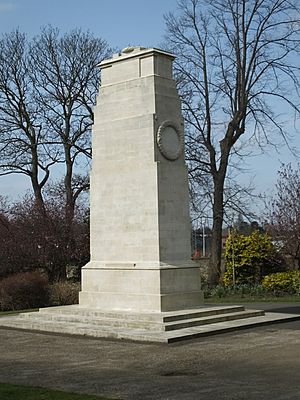Queen's Own Royal West Kent Regiment Cenotaph facts for kids
Quick facts for kids Queen's Own Royal West Kent Regiment Cenotaph |
|
|---|---|
| United Kingdom | |
 |
|
| For men of the Queen's Own Royal West Kent Regiment killed in the First World War | |
| Unveiled | 30 July 1921 |
| Location | 51°16′38″N 0°31′13″E / 51.277147°N 0.520369°E |
| Designed by | Sir Edwin Lutyens |
|
Listed Building – Grade II
|
|
| Official name | The Queen's Own Royal West Kent Regiment Cenotaph |
| Designated | 2 August 1974 |
| Reference no. | 1086395 |
The Queen's Own Royal West Kent Regiment Cenotaph is a special monument built to remember soldiers from the Queen's Own Royal West Kent Regiment. These brave men lost their lives during the First World War. You can find this memorial in Maidstone, a town in Kent, south-eastern England.
This important memorial was officially shown to the public in 1921. It was designed by a famous architect named Sir Edwin Lutyens. He also designed the well-known Cenotaph in Whitehall, London. Today, the Queen's Own Royal West Kent Regiment Cenotaph is a very important historical building, known as a grade II* listed building.
Contents
Why Were War Memorials Built?
Remembering Heroes After World War I
After the First World War, many people had lost family and friends. So many soldiers died that communities across Britain wanted to build special places to remember them. Thousands of these war memorials were created.
One of the most famous people who designed these memorials was Sir Edwin Lutyens. He was known as a top architect of his time. Lutyens designed the main Cenotaph in London, which is now a central place for national remembrance events.
He also created the huge Thiepval Memorial to the Missing in France, which is the biggest British war memorial in the world. Lutyens also designed the Stone of Remembrance, a special stone found in many large war cemeteries.
Lutyens' Cenotaphs Across England
The Queen's Own Royal West Kent memorial is one of seven cenotaphs in England that Lutyens designed. A cenotaph is like a tomb, but it's empty because the person's body isn't there. It's a symbol to remember them.
Two of Lutyens' cenotaphs were made specifically for army regiments. The Queen's Own Royal West Kent memorial is one of these. The other is for the Royal Berkshire Regiment War Memorial in Reading.
How the Queen's Own Royal West Kent Memorial Was Planned
In December 1918, a group of people decided to create a memorial for the Queen's Own Royal West Kent Regiment. This regiment had lost 6,866 men during the First World War. That's a huge number of lives.
They chose to have a smaller version of the famous Whitehall Cenotaph. They asked Sir Edwin Lutyens to design it. Even though Lutyens usually insisted his Stone of Remembrance should always be full-sized, he was happy to design a cenotaph that was two-thirds the size of the original.
History and Design of the Memorial
Building and Unveiling the Cenotaph
The memorial is located in Brenchley Gardens in Maidstone. A local company called GE Wallis and Sons built it.
The monument was officially unveiled on July 30, 1921. Major General Sir Edmund Leach, who was the colonel of the Queen's Own Royal West Kent Regiment, led the ceremony. The Archbishop of Canterbury, Randall Davidson, performed the dedication. Lieutenant General Sir Edwin Alderson also spoke to the crowds.
At the end of the event, the special flags (called "colours") of the regiment's reserve and volunteer battalions were placed in All Saints Church.
What the Cenotaph Looks Like
This cenotaph is very similar to the one in Whitehall, London. The main difference is that it's two-thirds the size, and it doesn't have flags on it.
It's made from a type of stone called Portland stone. The memorial has a chest-like shape at the top, with a carved laurel wreath on it. This top part sits on a base with three levels. The whole structure stands on a large rectangular shaft, which then rests on another two-level base. The entire monument stands on three shallow steps, which was a common design for Lutyens' memorials.
The memorial doesn't have many decorations. It only has a carved laurel wreath on two sides. Below these wreaths, you can see the dates of the two world wars. The dates for the Second World War were added later.
The two main sides of the memorial have important words carved into them. They say: "THE GLORIOUS DEAD / OF THE QUEEN'S OWN ROYAL WEST KENT REGIMENT / NUMBERING 6866 OF ALL RANKS / ALSO NUMBERING 1663 OF ALL RANKS". This remembers all the soldiers who died.
Protecting the Memorial's History
The memorial was first recognized as a grade II listed building on August 2, 1974. This means it's an important historical structure that needs to be protected.
In October 2015, during the 100-year anniversary of the First World War, all of Lutyens' war memorials were recognized as a "national collection." This led to many of his memorials being reviewed and updated on the National Heritage List for England. As part of this, the Queen's Own Royal West Kent Regiment Cenotaph was given an even higher status: it was upgraded to a grade II* listed building. The Royal Berkshire's memorial in Reading also received this upgrade.

